Why a smaller ask can be easier refuse

Richard Branson was sharing a story about introducing TV screens to the back of airplane seats.
He went to his board and the banks but couldn’t get the $10 million loan he needed to retrofit his Virgin Atlantic planes.
So instead he called Boeing and asked “if I buy 15 new planes, could you include seat back video screens?”
“Of course!”, came Boeing’s reply.
Branson’s point was he couldn’t get a loan for $10 million, but he could for $2 billion.
Sometimes a ‘small ask’ is easier to refuse
We assume incrementalism is easier to sell. A small change. A small investment.
But that’s not always the case.
A small change can be easier to refuse for two reasons:
1. Status quo salience
The closer you are to the existing status quo, the more salient the status quo is for those you are trying to convince. You’re dealing with a change to what’s known - what’s familiar - so they’ll readily jump to objections like:
- Opportunity cost e.g. what else could we do with that $10m?
- Sunk cost e.g. we’ve already invested in this and now you want us to change our plans?
- The risk of tinkering with something that’s working e.g. people are already flying with us and our competitors don’t have screens, so let’s hang off for now.
2. Easy to trivialise
A small change is usually easier to conceptualise, but this can be a problem. Nuance gets lost because people jump to what they assume it entails - they don’t see it as significant enough to ponder.
When you are asking for a large-scale change, there are more moving parts. Yes, it’s more complex but as such it requires deeper thought.
A larger scope also means less granularity and greater abstraction. In effect, people are required to imagine what this fuzzy new world will look like, and each will interpret that slightly differently and in a way that satisfies their own narrative.
Plus, as a rule, the larger the change program, the longer the time horizon. Any downside will be “future me’s” problem, whereas “now me” gets kudos for supporting this bold new plan.
The larger ask
By larger ask I’m not talking about an ambit claim where you ask for more than you want in the hope of landing a compromise. Ambit claims are disingenuous.
Instead I’m talking about shifting the playing field, like Branson did. The conversation was no longer about the pros and cons of video screens, it was about everything new planes represented.
A larger ask can work on a personal level, too. I wrote a few weeks ago about how I couldn’t change my ice-cream habit by tinkering. Instead I made a larger ask of myself - becoming vegan.
When to use the larger ask?
If the small change on its own doesn’t have sufficient value.
The installation of video screens wasn’t enough to convince Branson’s stakeholders that more customers would choose to fly Virgin. It was too easy to argue against. While the new planes came with a significantly larger price tag, they also came with a new swag of justifications.
When people are tired of the existing status quo.
In making a larger ask you have to convince people that the existing status quo is unacceptable so they don’t worry about sunk cost. As much as people are said to dislike change, they dislike being outdated and falling behind more because it strikes at their very identity. Branson knew this all too well, inviting his stakeholders to quite literally buy into the modernisation of Virgin Atlantic.
You might also find interesting:
- What to say to different personality types (blog)
- The fastest way to make your priority someone else's too (blog)
Image from https://pixabay.com/photos/airplane-cabin-passenger-aircraft-734363/

